Meguro Line
The Meguro Line (目黒線, Meguro-sen) is a railway line operated by Japanese private railway company Tokyu Corporation. As a railway line, the name is for the section between Meguro and Den-en-chōfu in southwest Tokyo, but nearly all trains run to Hiyoshi on a quad-tracked section of the Tōyoko Line in Yokohama, Kanagawa. Additionally, the Meguro line interoperates with the Tokyo Metro Namboku Line and Toei Mita Line beyond Meguro.
| Meguro Line | |||||||||||||||||||||||||||||||||||||||||||||||||||||||||||||||||||||||||||||||||||||||||||||||||||||||||||||||||||||||||||||||||||||||||||||||||||||||||||||||||||||||||||||||||||||||||||||||||||||||||||||||||||||||||||||||||||||||||||||||||||||||||||||||||||||||||||||||||||||||||||||||||||||||||||||||||||||||||||||||||||||||||||||||||||||||||||||||||||||||||||||||||||||||||||||||||||||||||||||||||||||||||||||||||||||||||||||||||||
|---|---|---|---|---|---|---|---|---|---|---|---|---|---|---|---|---|---|---|---|---|---|---|---|---|---|---|---|---|---|---|---|---|---|---|---|---|---|---|---|---|---|---|---|---|---|---|---|---|---|---|---|---|---|---|---|---|---|---|---|---|---|---|---|---|---|---|---|---|---|---|---|---|---|---|---|---|---|---|---|---|---|---|---|---|---|---|---|---|---|---|---|---|---|---|---|---|---|---|---|---|---|---|---|---|---|---|---|---|---|---|---|---|---|---|---|---|---|---|---|---|---|---|---|---|---|---|---|---|---|---|---|---|---|---|---|---|---|---|---|---|---|---|---|---|---|---|---|---|---|---|---|---|---|---|---|---|---|---|---|---|---|---|---|---|---|---|---|---|---|---|---|---|---|---|---|---|---|---|---|---|---|---|---|---|---|---|---|---|---|---|---|---|---|---|---|---|---|---|---|---|---|---|---|---|---|---|---|---|---|---|---|---|---|---|---|---|---|---|---|---|---|---|---|---|---|---|---|---|---|---|---|---|---|---|---|---|---|---|---|---|---|---|---|---|---|---|---|---|---|---|---|---|---|---|---|---|---|---|---|---|---|---|---|---|---|---|---|---|---|---|---|---|---|---|---|---|---|---|---|---|---|---|---|---|---|---|---|---|---|---|---|---|---|---|---|---|---|---|---|---|---|---|---|---|---|---|---|---|---|---|---|---|---|---|---|---|---|---|---|---|---|---|---|---|---|---|---|---|---|---|---|---|---|---|---|---|---|---|---|---|---|---|---|---|---|---|---|---|---|---|---|---|---|---|---|---|---|---|---|---|---|---|---|---|---|---|---|---|---|---|---|---|---|---|---|---|---|---|---|---|---|---|---|---|---|---|---|---|---|---|---|---|---|---|---|---|---|---|---|---|---|---|---|---|---|---|---|---|---|---|---|---|---|---|---|---|---|---|---|---|---|---|---|---|---|---|---|---|---|---|---|---|---|---|---|
| MG | |||||||||||||||||||||||||||||||||||||||||||||||||||||||||||||||||||||||||||||||||||||||||||||||||||||||||||||||||||||||||||||||||||||||||||||||||||||||||||||||||||||||||||||||||||||||||||||||||||||||||||||||||||||||||||||||||||||||||||||||||||||||||||||||||||||||||||||||||||||||||||||||||||||||||||||||||||||||||||||||||||||||||||||||||||||||||||||||||||||||||||||||||||||||||||||||||||||||||||||||||||||||||||||||||||||||||||||||||||
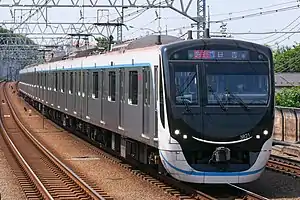 A Tokyu 3020 series train on the Meguro Line | |||||||||||||||||||||||||||||||||||||||||||||||||||||||||||||||||||||||||||||||||||||||||||||||||||||||||||||||||||||||||||||||||||||||||||||||||||||||||||||||||||||||||||||||||||||||||||||||||||||||||||||||||||||||||||||||||||||||||||||||||||||||||||||||||||||||||||||||||||||||||||||||||||||||||||||||||||||||||||||||||||||||||||||||||||||||||||||||||||||||||||||||||||||||||||||||||||||||||||||||||||||||||||||||||||||||||||||||||||
| Overview | |||||||||||||||||||||||||||||||||||||||||||||||||||||||||||||||||||||||||||||||||||||||||||||||||||||||||||||||||||||||||||||||||||||||||||||||||||||||||||||||||||||||||||||||||||||||||||||||||||||||||||||||||||||||||||||||||||||||||||||||||||||||||||||||||||||||||||||||||||||||||||||||||||||||||||||||||||||||||||||||||||||||||||||||||||||||||||||||||||||||||||||||||||||||||||||||||||||||||||||||||||||||||||||||||||||||||||||||||||
| Native name | 目黒線 | ||||||||||||||||||||||||||||||||||||||||||||||||||||||||||||||||||||||||||||||||||||||||||||||||||||||||||||||||||||||||||||||||||||||||||||||||||||||||||||||||||||||||||||||||||||||||||||||||||||||||||||||||||||||||||||||||||||||||||||||||||||||||||||||||||||||||||||||||||||||||||||||||||||||||||||||||||||||||||||||||||||||||||||||||||||||||||||||||||||||||||||||||||||||||||||||||||||||||||||||||||||||||||||||||||||||||||||||||||
| Owner | Tokyu Corporation | ||||||||||||||||||||||||||||||||||||||||||||||||||||||||||||||||||||||||||||||||||||||||||||||||||||||||||||||||||||||||||||||||||||||||||||||||||||||||||||||||||||||||||||||||||||||||||||||||||||||||||||||||||||||||||||||||||||||||||||||||||||||||||||||||||||||||||||||||||||||||||||||||||||||||||||||||||||||||||||||||||||||||||||||||||||||||||||||||||||||||||||||||||||||||||||||||||||||||||||||||||||||||||||||||||||||||||||||||||
| Locale | Tokyo | ||||||||||||||||||||||||||||||||||||||||||||||||||||||||||||||||||||||||||||||||||||||||||||||||||||||||||||||||||||||||||||||||||||||||||||||||||||||||||||||||||||||||||||||||||||||||||||||||||||||||||||||||||||||||||||||||||||||||||||||||||||||||||||||||||||||||||||||||||||||||||||||||||||||||||||||||||||||||||||||||||||||||||||||||||||||||||||||||||||||||||||||||||||||||||||||||||||||||||||||||||||||||||||||||||||||||||||||||||
| Termini | |||||||||||||||||||||||||||||||||||||||||||||||||||||||||||||||||||||||||||||||||||||||||||||||||||||||||||||||||||||||||||||||||||||||||||||||||||||||||||||||||||||||||||||||||||||||||||||||||||||||||||||||||||||||||||||||||||||||||||||||||||||||||||||||||||||||||||||||||||||||||||||||||||||||||||||||||||||||||||||||||||||||||||||||||||||||||||||||||||||||||||||||||||||||||||||||||||||||||||||||||||||||||||||||||||||||||||||||||||
| Stations | 13 | ||||||||||||||||||||||||||||||||||||||||||||||||||||||||||||||||||||||||||||||||||||||||||||||||||||||||||||||||||||||||||||||||||||||||||||||||||||||||||||||||||||||||||||||||||||||||||||||||||||||||||||||||||||||||||||||||||||||||||||||||||||||||||||||||||||||||||||||||||||||||||||||||||||||||||||||||||||||||||||||||||||||||||||||||||||||||||||||||||||||||||||||||||||||||||||||||||||||||||||||||||||||||||||||||||||||||||||||||||
| Color on map | Sky Blue (#009bd8) | ||||||||||||||||||||||||||||||||||||||||||||||||||||||||||||||||||||||||||||||||||||||||||||||||||||||||||||||||||||||||||||||||||||||||||||||||||||||||||||||||||||||||||||||||||||||||||||||||||||||||||||||||||||||||||||||||||||||||||||||||||||||||||||||||||||||||||||||||||||||||||||||||||||||||||||||||||||||||||||||||||||||||||||||||||||||||||||||||||||||||||||||||||||||||||||||||||||||||||||||||||||||||||||||||||||||||||||||||||
| Service | |||||||||||||||||||||||||||||||||||||||||||||||||||||||||||||||||||||||||||||||||||||||||||||||||||||||||||||||||||||||||||||||||||||||||||||||||||||||||||||||||||||||||||||||||||||||||||||||||||||||||||||||||||||||||||||||||||||||||||||||||||||||||||||||||||||||||||||||||||||||||||||||||||||||||||||||||||||||||||||||||||||||||||||||||||||||||||||||||||||||||||||||||||||||||||||||||||||||||||||||||||||||||||||||||||||||||||||||||||
| Type | Commuter rail | ||||||||||||||||||||||||||||||||||||||||||||||||||||||||||||||||||||||||||||||||||||||||||||||||||||||||||||||||||||||||||||||||||||||||||||||||||||||||||||||||||||||||||||||||||||||||||||||||||||||||||||||||||||||||||||||||||||||||||||||||||||||||||||||||||||||||||||||||||||||||||||||||||||||||||||||||||||||||||||||||||||||||||||||||||||||||||||||||||||||||||||||||||||||||||||||||||||||||||||||||||||||||||||||||||||||||||||||||||
| Daily ridership | 388,982 (FY 2018)[1] | ||||||||||||||||||||||||||||||||||||||||||||||||||||||||||||||||||||||||||||||||||||||||||||||||||||||||||||||||||||||||||||||||||||||||||||||||||||||||||||||||||||||||||||||||||||||||||||||||||||||||||||||||||||||||||||||||||||||||||||||||||||||||||||||||||||||||||||||||||||||||||||||||||||||||||||||||||||||||||||||||||||||||||||||||||||||||||||||||||||||||||||||||||||||||||||||||||||||||||||||||||||||||||||||||||||||||||||||||||
| Technical | |||||||||||||||||||||||||||||||||||||||||||||||||||||||||||||||||||||||||||||||||||||||||||||||||||||||||||||||||||||||||||||||||||||||||||||||||||||||||||||||||||||||||||||||||||||||||||||||||||||||||||||||||||||||||||||||||||||||||||||||||||||||||||||||||||||||||||||||||||||||||||||||||||||||||||||||||||||||||||||||||||||||||||||||||||||||||||||||||||||||||||||||||||||||||||||||||||||||||||||||||||||||||||||||||||||||||||||||||||
| Line length | 11.9 km (7.4 mi) | ||||||||||||||||||||||||||||||||||||||||||||||||||||||||||||||||||||||||||||||||||||||||||||||||||||||||||||||||||||||||||||||||||||||||||||||||||||||||||||||||||||||||||||||||||||||||||||||||||||||||||||||||||||||||||||||||||||||||||||||||||||||||||||||||||||||||||||||||||||||||||||||||||||||||||||||||||||||||||||||||||||||||||||||||||||||||||||||||||||||||||||||||||||||||||||||||||||||||||||||||||||||||||||||||||||||||||||||||||
| Track gauge | 1,067 mm (3 ft 6 in) | ||||||||||||||||||||||||||||||||||||||||||||||||||||||||||||||||||||||||||||||||||||||||||||||||||||||||||||||||||||||||||||||||||||||||||||||||||||||||||||||||||||||||||||||||||||||||||||||||||||||||||||||||||||||||||||||||||||||||||||||||||||||||||||||||||||||||||||||||||||||||||||||||||||||||||||||||||||||||||||||||||||||||||||||||||||||||||||||||||||||||||||||||||||||||||||||||||||||||||||||||||||||||||||||||||||||||||||||||||
| Electrification | 1,500 V DC overhead catenary | ||||||||||||||||||||||||||||||||||||||||||||||||||||||||||||||||||||||||||||||||||||||||||||||||||||||||||||||||||||||||||||||||||||||||||||||||||||||||||||||||||||||||||||||||||||||||||||||||||||||||||||||||||||||||||||||||||||||||||||||||||||||||||||||||||||||||||||||||||||||||||||||||||||||||||||||||||||||||||||||||||||||||||||||||||||||||||||||||||||||||||||||||||||||||||||||||||||||||||||||||||||||||||||||||||||||||||||||||||
| |||||||||||||||||||||||||||||||||||||||||||||||||||||||||||||||||||||||||||||||||||||||||||||||||||||||||||||||||||||||||||||||||||||||||||||||||||||||||||||||||||||||||||||||||||||||||||||||||||||||||||||||||||||||||||||||||||||||||||||||||||||||||||||||||||||||||||||||||||||||||||||||||||||||||||||||||||||||||||||||||||||||||||||||||||||||||||||||||||||||||||||||||||||||||||||||||||||||||||||||||||||||||||||||||||||||||||||||||||
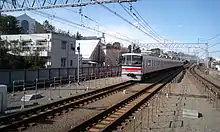
Meguro Line tracks run parallel with the Tōyoko Line between Den-en-chōfu and Hiyoshi stations (inside tracks - Meguro Line, outside tracks - Tōyoko Line)
History
- 1923:
- 1924, June 1: Koyama becomes Musashi-Koyama.[1]
- 1926, January 1: Chōfu and Tamagawa stations are renamed to Den-en-Chōfu and Maruko-Tamagawa stations respectively.[1]
- 1928, August 1: Nishi-Koyama station opens.
- 1931, January 1: Maruko-Tamagawa station is renamed again to Tamagawa-en-mae station.[1]
- 1977, December 16: Tamagawa-en-mae station is renamed yet again to Tamagawa-en station.[1]
- 1994, November 27: Den-en-Chōfu station moves underground.
- 1997:
- June 27: Ōokayama station moves underground.
- July 27: Meguro station moves underground.
- 1999, October 10: Fudōmae station is elevated.
- 2000:
- 2001, March 28: Through service begins with the Saitama Rapid Railway line via the Namboku line.[3]
- 2006:
- 2008 June 22: Service extended to Hiyoshi.[3]
- 2022 April: Eight-car trains commence operation on the line.[4] Platforms on Meguro Line were lengthened in order to accommodate 8-car trainsets and allow through services with Sōtetsu Shin-yokohama Line.[4]
- 2023 March 18: The through service onto the Sōtetsu Shin-yokohama Line began service.[5] Since then, most express trains no longer terminate at Hiyoshi but instead either Shin-yokohama, Nishiya, Shōnandai, Yamato or Ebina. The majority of local trains still terminate at Hiyoshi.[6]
Stations
| No. | Station | Japanese | Express | Transfers | Location | |
|---|---|---|---|---|---|---|
| ↑ Through-running to/from↑
NTokyo Metro Namboku Line towards Urawa-misono via the SRSaitama Rapid Railway Line IToei Mita Line towards Nishi-takashimadaira | ||||||
| MG01 I01 N01 | Meguro | 目黒 | ● | Shinagawa | Tokyo | |
| MG02 | Fudō-mae | 不動前 | | | |||
| MG03 | Musashi-koyama | 武蔵小山 | ● | |||
| MG04 | Nishi-koyama | 西小山 | | | |||
| MG05 | Senzoku | 洗足 | | | Meguro | ||
| MG06 | Ōokayama | 大岡山 | ● | OM Oimachi Line | Ōta | |
| MG07 | Okusawa | 奥沢 | | | Setagaya | ||
| MG08 | Den-en-chōfu | 田園調布 | ● | TY Tōyoko Line | Ōta | |
| MG09 | Tamagawa | 多摩川 | ● |
| ||
| MG10 | Shin-maruko | 新丸子 | | | TY Tōyoko Line | Nakahara-ku, Kawasaki | Kanagawa |
| MG11 | Musashi-kosugi | 武蔵小杉 | ● |
| ||
| MG12 | Motosumiyoshi | 元住吉 | | | TY Tōyoko Line | ||
| MG13 | Hiyoshi | 日吉 | ● |
|
Kōhoku-ku, Yokohama | |
| ↓ Through-running to/from ↓
SH Tōkyū Shin-yokohama Line for Shin-yokohama
| ||||||
Ridership
| Year | Ridership |
|---|---|
| 2010 | 321,677[7] |
| 2011 | 324,052[8] |
| 2012 | 332,590[9] |
| 2013 | 342,041[10] |
| 2014 | 347,884[11] |
| 2015 | 358,274[12] |
| 2016 | 368,386[13] |
| 2017 | 379,212[14] |
| 2018 | 388,982[1] |
Rolling stock
Tokyu
- 3000 series 8-car EMUs
- 3020 series 8-car EMUs[4]
- 5080 series 8-car EMUs
Other operators
- Toei 6300 series 6-car EMUs (Toei Mita Line)
- Toei 6500 series 8-car EMUs (Toei Mita Line)[15][16]
- Tokyo Metro 9000 series 6-car EMUs (Tokyo Metro Namboku Line)
- Saitama Rapid Railway 2000 series 6-car EMUs (Saitama Rapid Railway Line)
- Sotetsu 21000 series 8-car EMUs (Sōtetsu Main Line or Sōtetsu Izumino Line, via the Sōtetsu Shin-Yokohama Line)[17]
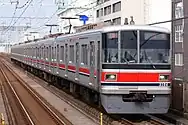 Tokyu 3000 series
Tokyu 3000 series Tokyu 3020 series
Tokyu 3020 series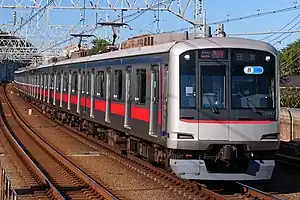 Tokyu 5080 series
Tokyu 5080 series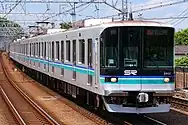 Saitama Rapid Railway 2000 series
Saitama Rapid Railway 2000 series Toei 6300 series
Toei 6300 series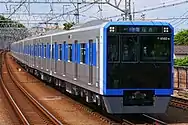 Toei 6500 series
Toei 6500 series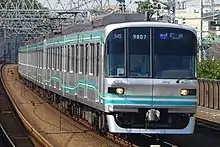 Tokyo Metro 9000 series
Tokyo Metro 9000 series Sotetsu 21000 series
Sotetsu 21000 series
Former connecting lines
- Okusawa station - A 1 km (0.62 mi) 1,067 mm (3 ft 6 in) gauge line, electrified at 600 VDC, from Shin-Okusawa operated between 1928 and 1935, providing a connection to Yukigaya-Otsuka on the Tokyu Ikegami Line.
See also
References
- "TOKYU CORPORATION 2019-2020". Retrieved 18 Mar 2020.
- "Tokyu Meguro Line". All About Japanese Trains. Retrieved 2020-03-18.
- "年譜 |東急電鉄". www.tokyu.co.jp. Retrieved 2020-03-18.
- "東急目黒線・東京メトロ南北線など、8両編成の列車が営業運転開始". Mynavi News (in Japanese). 2022-04-05. Retrieved 2022-04-05.
- "相模鉄道,3月18日にダイヤ改正を実施" [Sagami Railway implements timetable revision on March 18]. Japan Railfan Magazine Online (in Japanese). Archived from the original on 17 December 2022. Retrieved 17 December 2022.
- Train Departures of Meguro Line (PDF) (in Japanese), Tōkyū Railways, retrieved 2023-03-10
- "TOKYU CORPORATION 2011-2012". www.tokyu.co.jp. Retrieved 2020-03-18.
- "TOKYU CORPORATION 2012-2013". www.tokyu.co.jp. Retrieved 2020-03-18.
- "TOKYU CORPORATION 2013-2014". www.tokyu.co.jp. Retrieved 2020-03-18.
- "TOKYU CORPORATION 2014-2015". www.tokyu.co.jp. Retrieved 2020-03-18.
- "TOKYU CORPORATION 2015-2016". www.tokyu.co.jp. Retrieved 2020-03-18.
- "TOKYU CORPORATION 2016-2017". www.tokyu.co.jp. Retrieved 2020-03-18.
- "TOKYU CORPORATION 2017-2018". www.tokyu.co.jp. Retrieved 2020-03-18.
- "TOKYU CORPORATION 2018-2019". www.tokyu.co.jp. Retrieved 2020-03-18.
- "都営三田線の新型車両6500形、車内もシンプルな造形に - 写真68枚" [New, simplistic 6500 series of the Toei Mita Line]. Mynavi News (in Japanese). 2022-02-17. Retrieved 2022-03-25.
- "東京都交通局6500形が営業運転を開始" [Tokyo Metropolitan Bureau of Transportation 6500 series begins commercial operation]. Japan Railfan Magazine Online (in Japanese). Japan: Koyusha Co., Ltd. 15 May 2022. Retrieved 2022-05-25.
- Kinoshita, Kenji (2021-09-02). "相鉄21000系「東急線内は目黒線直通用」9月デビュー! グッズも発売" [Sotetsu 21000 series to debut in September!]. Mynavi News (in Japanese). Retrieved 2022-03-25.
This article is issued from Wikipedia. The text is licensed under Creative Commons - Attribution - Sharealike. Additional terms may apply for the media files.